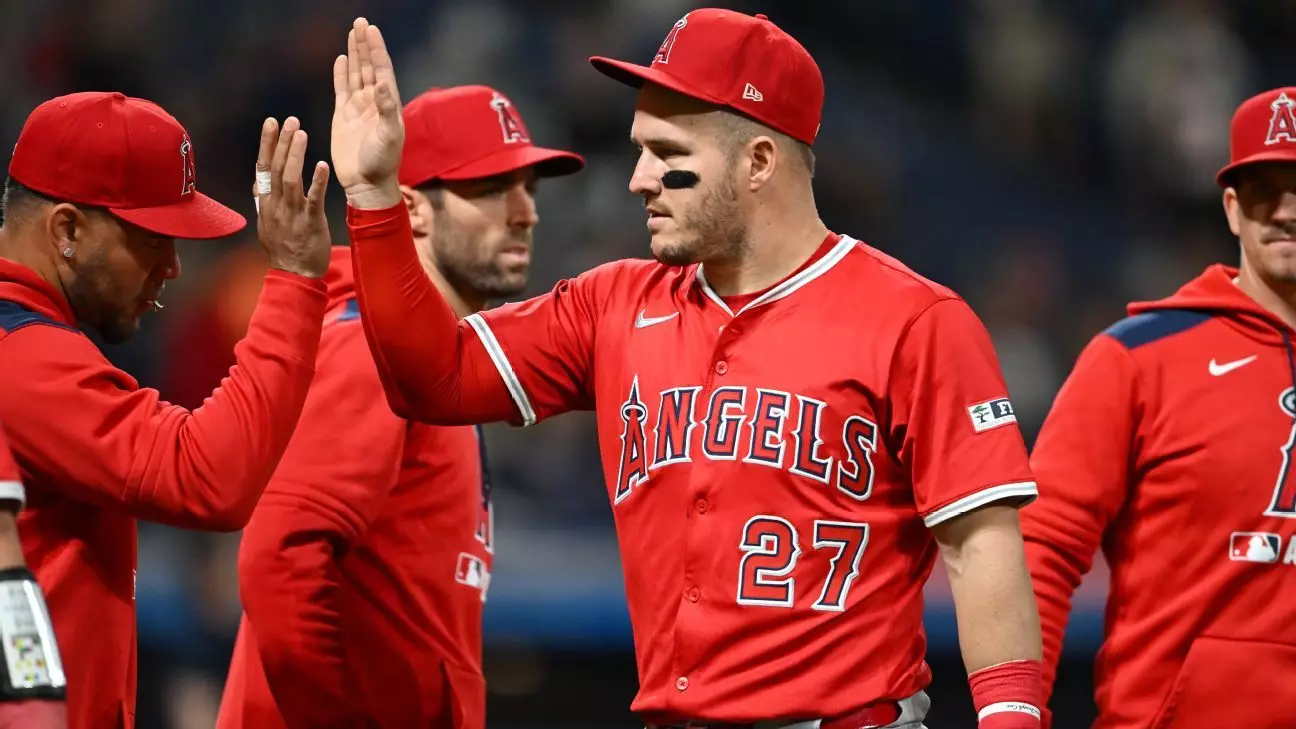The Los Angeles Angels’ star, Mike Trout, has made a notable return to Major League Baseball, reigniting excitement among fans and the team alike. Originally, Trout’s return was slated for the upcoming series in Boston, but as fate would have it, he was called back into action ahead of schedule. Activated from the injured list, Trout made his first appearance in the Angels’ lineup against the Cleveland Guardians after missing 26 games due to a bone bruise in his left knee. This injury, which ultimately required two surgeries last year, befell Trout like a storm cloud during a sunny day, yet his perseverance shone brightly as he stepped back into the batter’s box.
Trout’s first game back was a testament to his grit, as he went 1-for-5 in a 4-1 victory, filling the designated hitter role. The numbers, while not spectacular on the surface, tell a larger story about a player battling through adversity. “Felt good,” Trout commented on his performance, reflecting an optimism that is often absent in athletes when they first come back from injury. Despite striking out twice, he managed to deliver a solid hit that provided a flicker of hope for Angels fans, solidifying his role as a vital piece of the puzzle.
Adjustment and Adaptation: A New Role
Trout’s batting order placement was equally intriguing, hitting fifth for the first time in 1,532 career starts. This was not merely a statistical anomaly but a strategic decision by Angels manager Ron Washington, aimed at easing Trout back into the fray while maintaining the team’s overall balance. As remarkable as Trout’s track record is, baseball is a team sport, and adapting to changing roles is crucial for success. Washington’s approach underscores a significant shift in perspective: Trout must not only adjust his batting order but also prepare for an evolving role within the lineup, as both a leader and protector.
Washington’s sentiment, “He’s not ready to be at the top of the lineup, especially with those guys up there,” reveals a commitment to Trout’s health over immediate team needs. This is a forward-thinking strategy essential for a player with as much investment in the franchise as Trout has. His path has been marred with injuries since May 2021 when he suffered a calf tear, leading to missed games and extended stays on the injured list. The wear of sustained injury challenges any athlete’s mindset, and for Trout, it’s about not just physical readiness but psychological resilience.
Statistical Insights into Trout’s Performance
Despite the injuries, Trout’s batting averages remain respectable considering the circumstances. With a .180 average and 9 home runs over 30 games, statistical enthusiasts are left to wonder if this performance reflects a declining trend or merely an aberration during recovery. Many view his time as a designated hitter for this season as a necessary compromise to his prowess, as he comforts himself with the reality that he has produced effectively from this position: a batting average of .273, with 6 homers and 9 RBIs in just 8 games. Numbers may falter, but the superstar’s heart and determination do not.
In discussions about his approach, Trout mentioned the complexities of dealing with a bone bruise, emphasizing the importance of caution upon his return. His awareness of needing to temper his enthusiasm speaks volumes about the maturity and wisdom developed through seasons of battling injuries. Consequently, Trout’s comments resonate: “I definitely have to be cautious, especially the first couple games.” This level of introspection may become the cornerstone of how athletes today handle return-to-play decisions.
The Bigger Picture for the Angels
Trout’s re-entry into the lineup brought a collective sigh of relief, punctuating a long five-game losing streak for the Angels as they strive for consistency in a challenging season marred by injuries. His return is more than just a personal win; it’s a rallying call for a franchise that has faced its fair share of hurdles. Fellow Angels players, recognizing Trout’s indispensable role, have expressed how pivotal his comeback is for team morale. Young players, like Logan O’Hoppe, clearly idolize Trout, referring to him as the “heart of this organization.”
This narrative is not merely one of a player returning from injury but a deeper exploration of an athlete’s indomitable spirit against adversity. Trout’s journey exemplifies resilience, strategic adaptation, and a sense of responsibility to his team. It raises pivotal questions about how the game evolves around superstars like him and how the collective aspirations of a team can align with the health and performance of its key players. The next chapters of Trout’s story could potentially redefine how we perceive athlete longevity and adaptability in the ever-challenging arena of professional sports.

